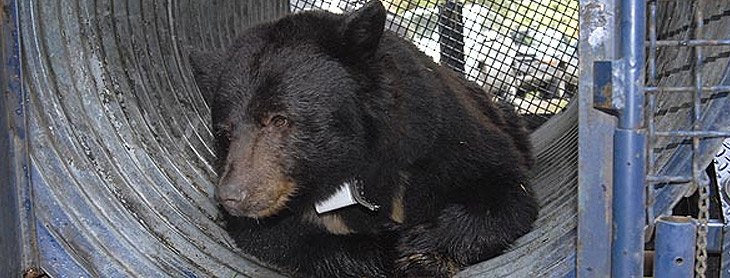
Under certain circumstances, it is necessary for wildlife managers to capture bears in order to move them out of conflict situations. Bears can be “hard” released on-site with negative conditioning; or translocated to a more suitable area and released “softly” (i.e. without negative conditioning). There are various techniques used to capture bears e.g. live traps, leg snares and tranquilization. (Capture poles can also be used to catch cubs under 35 lbs.)
There is no evidence that [trapping and drugging a bear] can turn it into a more aggressive individual – [it] makes neither grizzlies or black bears more dangerous to people… Steve Herrero in Bear Attacks: Their Causes and Avoidance (pg 241)
These techniques are often used to avoid lethal approaches. However, capture and handling can cause long-term tissue injury as a result of dart trauma, leg hold snares, tooth extraction and attachment of telemetric devices. There is also a risk of capture myopathy resulting in mortality in approximately two per cent of animals (Cattet et al 2008). Mortality may occur within minutes or may take several days, weeks or even months.
Live Trap
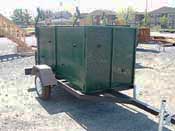 A live trap is essentially a large cage used to catch bears without causing harm or death. The trap is baited to encourage the bear to enter. When the bear takes the bait, the trap door automatically closes and locks the bear inside. Some live traps are mounted on a trailer with wheels so that they can be towed by a vehicle. Live trap styles vary greatly – culvert traps and barrel traps are still widely used. Traps must be child/bear-friendly and family units must be live trapped and released together.
A live trap is essentially a large cage used to catch bears without causing harm or death. The trap is baited to encourage the bear to enter. When the bear takes the bait, the trap door automatically closes and locks the bear inside. Some live traps are mounted on a trailer with wheels so that they can be towed by a vehicle. Live trap styles vary greatly – culvert traps and barrel traps are still widely used. Traps must be child/bear-friendly and family units must be live trapped and released together.
Advantages:
- Can be used in residential areas
- Tends to be favoured by public (likely because of its familiarity)
- Quick and easy to set up and little training is required
- Usually non-injurious to the bear, when the proper equipment and precautions are taken. See information re: A Child/Bear-Friendly Live Trap.
- Can be monitored by local homeowner, park manager, etc.
Disadvantages:
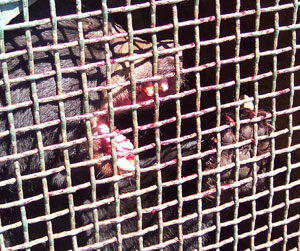
- Catch rate for culvert traps only about 20% (catch rate can be improved by using a “see-through” trap)
- Traps with large mesh can be injurious to bears. See information re: A Child/Bear-Friendly Live Trap.
- Domestic animals or non-target species may be captured
- Potential safety risk for curious people, particularly children that might get caught
- A bear may become ‘trap-shy’ if repeat captures are necessary
- Difficult, and usually inappropriate, to capture family units
- Susceptible to interference/damage by the public
Box traps
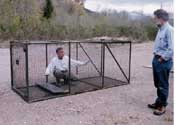 Box traps are another viable alternative to culvert traps for bears that are wary or trap-shy. Like the “child/bear-friendly live trap”, the mesh wire construction may reduce wariness by allowing the bears to view their surroundings while they are entering the trap. The wire mesh must be tightly woven to prevent the bears from biting the wire and damaging their teeth and claws. The box trap also offers greater stability as it is placed on the ground, making it easier for trap-shy bears to enter.
Box traps are another viable alternative to culvert traps for bears that are wary or trap-shy. Like the “child/bear-friendly live trap”, the mesh wire construction may reduce wariness by allowing the bears to view their surroundings while they are entering the trap. The wire mesh must be tightly woven to prevent the bears from biting the wire and damaging their teeth and claws. The box trap also offers greater stability as it is placed on the ground, making it easier for trap-shy bears to enter.
Advantages:
- usefulness in catching “trap-shy” bears
- minimal risk of injury to the bears
Disadvantages:
- involve the logistical considerations in moving the trap from location to location
- loading an occupied trap into a vehicle
Leg Snares
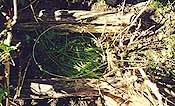
A leg snare is comprised of a spring, a circle of 3/16″ (for black bears) or 1/4″ (for grizzly) aircraft cable, and a locking mechanism. It is designed to catch the bear by the leg.
Leg snares must be signed, alarmed and monitored frequently (at least every two hours) to prevent injury and stress to the bear or accidental snaring of cubs, people, pets or other animals.
Unfortunately, most injuries occur shortly after being caught. Snares must be properly set to reduce injury rates and should only be used by people with adequate training in their safe use. Leg snares should be used as a last resort to catch bears that could not be live-trapped.
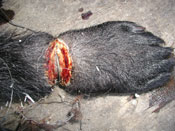
Snare Injury. Photo Credit: OMNR, 2005. Due to the concern for injury, the Ontario Ministry of Natural Resources prohibits the use of snares to capture problem bears.
Advantages
- Can be used in some areas where live traps cannot be set
- Effective
- Inexpensive
Disadvantages
- Can cause severe physical injury to the bear if not properly set and monitored
- Must be monitored every couple of hours or less
- Not advisable for use in urban areas unless continuously monitored
- Difficult to capture family units
- May capture/injure non-target animals or people if not set, signed and monitored properly
- Has to be followed by immobilization i.e. jab-stick/dart which can be risky for handle
Sierra Club US 2012 Policy on Trapping Wildlife
Use of body-gripping devices* – including leghold traps, snares, and Conibear® traps – are indiscriminate to age, sex and species and typically result in injury, pain, suffering, and/or death of target and non-target animals. The Sierra Club considers body-gripping, restraining and killing traps and snares to be ecologically indiscriminate and unnecessarily inhumane and therefore opposes their use.
The Sierra Club promotes and supports humane, practical and effective methods of mitigating human-wildlife conflicts and actively discourages the use of inhumane and indiscriminate methods. Sierra Club recognizes the rights of indigenous peoples under federal laws and treaties granting rights of self-determination and rights to pursue subsistence taking of wildlife. *Body gripping device – includes, but is not limited to, any snare (neck, body, or leg), kill-type trap (such as the Conibear®), leghold trap (including steel-jaw, padded, offset), and any other device designed to grip a body or body part. This definition includes any device that may result in injury or death because of the mechanism of entrapment. Live cage and box traps, and common rat and mousetraps shall not be considered body-gripping devices. ~ Sierra Club Board of Directors, May 19, 2012
Darting - Chemical Immobilization (Tranquilization)
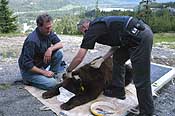 Chemical immobilization is used to temporarily immobilize a bear through the injection of a drug which temporarily affects the ability of the bear to use its muscles. It is most frequently administered to bears by a dart from a capture gun or by a two metre-long jab-stick with a syringe mounted on the end. Proper certification is necessary to administer any type of chemical immobilization.
Chemical immobilization is used to temporarily immobilize a bear through the injection of a drug which temporarily affects the ability of the bear to use its muscles. It is most frequently administered to bears by a dart from a capture gun or by a two metre-long jab-stick with a syringe mounted on the end. Proper certification is necessary to administer any type of chemical immobilization.
To reduce injury to animals, remote drug delivery systems should (Cattet et al 2005):
- hit the target with high accuracy (low bias and high precision);
- use lightweight, low-velocity (40-50 m/s) darts;
- use slow-injection darts;
- use side-ported needles; and
- use large diameter needle seals.
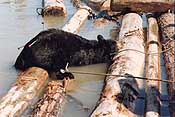 Blow pipes may also be used to administer the chemicals and result in fewer injuries since they are powered only by a person’s lungs and the drug is injected into the animal via low air pressure. Needles may be used if the bear is already immobilized and the initial dose needs to be topped up.
Blow pipes may also be used to administer the chemicals and result in fewer injuries since they are powered only by a person’s lungs and the drug is injected into the animal via low air pressure. Needles may be used if the bear is already immobilized and the initial dose needs to be topped up.
Advantages
- Can be used under a variety of circumstances
- Capture guns effective at long range
- Provides an alternative to destruction when removal is necessary
- Relatively inexpensive
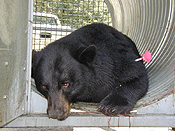 Disadvantages
Disadvantages
- Not instantaneous – can take considerable time to take effect, during which time the bear may move, climb a tree, enter water or charge. Thus, it works best if the bear is in a contained area
- Potential for overdosing if several darts are needed or handler is unsure how much drug is injected on each try
- Shooting a bear at too close a range can cause injury or death, especially if vital areas are hit (shots at moving/treed bears do not always hit intended muscle mass)
- Potentially dangerous to personnel using the drugs or public if a drug-loaded dart is lost near human habitation or ricochets off bear/tree/fence etc. and hits bystanders
- Proper certification is necessary to administer any type of chemical immobilization
Capture Pole
![]() A capture pole can be used to capture cubs-of-the-year that are under 16 kg (35 lbs). Be sure that the pole cable ensnares at least one shoulder of the cub along with the neck. Don’t ensnare the neck alone. Cubs are often stronger than anticipated. It may be quite difficult to use a catch pole to remove a cub from a tree, unless you use a jab stick to “lightly” tranquilize them first (using Ketamine alone; no Rompun).
A capture pole can be used to capture cubs-of-the-year that are under 16 kg (35 lbs). Be sure that the pole cable ensnares at least one shoulder of the cub along with the neck. Don’t ensnare the neck alone. Cubs are often stronger than anticipated. It may be quite difficult to use a catch pole to remove a cub from a tree, unless you use a jab stick to “lightly” tranquilize them first (using Ketamine alone; no Rompun).
Once caught, the cub can be contained and/or transported in a dog carrier. If you suspect the cub is orphaned, contact the local wildlife agency to make arrangements to take the cub to a certified rehabilitation centre. Generally speaking, cubs can be assumed to be orphaned if a sow has not returned to care for her cubs during an eight-hour period.
Advantages
- Safer
- Inexpensive
Disadvantages
- Animal must be small enough to be kept under control or there is a possibility of the cub escaping with the catch pole around its neck
- Injury can occur if used improperly.
Resources:
ONLINE CHEMICAL CAPTURE COURSES: click here for course on humane and respectful capture and handling of captive and free-ranging wildlife animals – taught by Dr. Mark Johnson, Global Wildlife Resources.
For information on immobilization and trap safety, refer to: Managing Bear Conflict: A Manual for WDFW Field Personnel, Section 2. Click here to review.
An Evaluation of Long-term Capture Effects in Ursids: Implications for wildlife welfare and research by Cattet et al. Click here to download.
